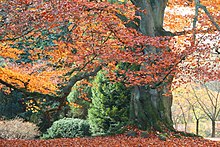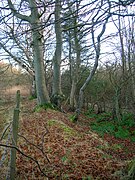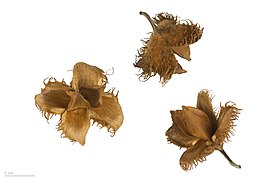Fagus sylvatica
| Fagus sylvatica | |
|---|---|

| |
| Alpine forest (Italy) | |
| Scientific classification | |
| Kingdom: | Plantae |
| Clade: | Tracheophytes |
| Clade: | Angiosperms |
| Clade: | Eudicots |
| Clade: | Rosids |
| Order: | Fagales |
| Family: | Fagaceae |
| Genus: | Fagus |
| Species: | F. sylvatica
|
| Binomial name | |
| Fagus sylvatica | |

| |
| Distribution map Fagus sylvatica Fagus orientalis (syn. F. sylvatica subsp. orientalis) | |
| Synonyms[2] | |
| |
Fagus sylvatica, the European beech or common beech is a large, graceful deciduous tree in the beech family with smooth silvery-gray bark, large leaf area, and a short trunk with low branches.[3]
Description


Fagus sylvatica is a large tree, capable of reaching heights of up to 50 metres (160 feet) tall[4] and 3 m (10 ft) trunk diameter, though more typically 25–35 m (82–115 ft) tall and up to 1.5 m (5 ft) trunk diameter. A 10-year-old sapling will stand about 4 m (13 ft) tall. Undisturbed, the European beech has a lifespan of 300 years; one tree at the Valle Cervara site was more than 500 years old—the oldest known in the northern hemisphere.[5] In cultivated forest stands trees are normally harvested at 80–120 years of age.[6] 30 years are needed to attain full maturity (as compared to 40 for American beech). Like most trees, its form depends on the location: in forest areas, F. sylvatica grows to over 30 m (100 ft), with branches being high up on the trunk. In open locations, it will become much shorter (typically 15–24 m or 50–80 ft) and more massive.
The leaves are alternate, simple, and entire or with a slightly
The leaves of beech are often not
Small quantities of seeds may be produced around 10 years of age, but not a heavy crop until the tree is at least 30 years old. F. sylvatica male flowers are borne in the small catkins which are a hallmark of the Fagales order (beeches, chestnuts, oaks, walnuts, hickories, birches, and hornbeams). The female flowers produce beechnuts, small triangular nuts 15–20 mm (5⁄8–3⁄4 in) long and 7–10 mm (1⁄4–3⁄8 in) wide at the base; there are two nuts in each cupule, maturing in the autumn 5–6 months after pollination. Flower and seed production is particularly abundant in years following a hot, sunny and dry summer, though rarely for two years in a row.
Distribution and habitat

The European beech is the most abundant hardwood species in Austrian, German and Swiss forests.[7] The native range extends from the north, in Sweden, Denmark, Norway, Germany, Poland, Switzerland, Bulgaria, eastern parts of Russia, Romania, through Europe to France, southern England, Spain (on the Cantabrian, Iberian and Central mountain ranges),[8] and east to northwest Turkey,[2] where it exhibits an interspecific cline with the oriental beech (Fagus orientalis), which replaces it further east. In the Balkans, it shows some hybridisation with oriental beech; these hybrid trees are named Fagus × taurica Popl. [Fagus moesiaca (Domin, Maly) Czecz.]. In the southern part of its range around the Mediterranean, and Sicily,[9] it grows only in mountain forests, at 600–1,800 m (1,969–5,906 ft) altitude.
Although often regarded as native in southern England, recent evidence suggests that F. sylvatica did not arrive in England until about 4000 BC, or 2,000 years subsequent to the English Channel forming following the ice ages; it could have been an early introduction by
Though not demanding of its soil type, the European beech has several significant requirements: a humid atmosphere (precipitation well distributed throughout the year and frequent fogs) and well-drained soil (being intolerant of excessive stagnant water). It prefers moderately fertile ground, calcified or lightly acidic, therefore it is found more often on the side of a hill than at the bottom of clayey basin. It tolerates rigorous winter cold, but is sensitive to spring frost. In Norway's oceanic climate planted trees grow well north to Bodø, and produce seedlings and can spread naturally in Trondheim.[14] In Sweden, beech trees do not grow as far north as in Norway.[15]
A beech forest is very dark and few species of plant are able to survive there, where the sun barely reaches the ground. Young beeches prefer some shade and may grow poorly in full sunlight. In a clear-cut forest a European beech will germinate and then die of excessive dryness. Under oaks with sparse leaf cover it will quickly surpass them in height and, due to the beech's dense foliage, the oaks will die from lack of sunlight.
Ecology
The root system is shallow, even superficial, with large roots spreading out in all directions. European beech forms ectomycorrhizas with a range of fungi including many Russula species, as well as Laccaria amethystina,[16] and with the species Ramaria flavosaponaria.[17] Tomentella Pat. species and Cenococcum geophilum have been found in Danish and Spanish beech forests. These fungi are important in enhancing uptake of water and nutrients from the soil.[16]
In the woodlands of southern Britain, beech is dominant over oak and elm south of a line from about north Suffolk across to Cardigan. Oak are the dominant forest trees north of this line. One of the most beautiful European beech forests called
Spring leaf budding by the European beech is triggered by a combination of day length and temperature. Bud break each year is from the middle of April to the beginning of May, often with remarkable precision (within a few days). It is more precise in the north of its range than the south, and at 600 m (2,000 ft) than at sea level.[23]
The European beech invests significantly in summer and autumn for the following spring. Conditions in summer, particularly good rainfall, determine the number of leaves included in the buds. In autumn, the tree builds the reserves that will sustain it into spring. Given good conditions, a bud can produce a shoot with ten or more leaves. The terminal bud emits a hormonal substance in the spring that halts the development of additional buds. This tendency, though very strong at the beginning of their existence, becomes weaker in older trees.
It is only after the budding that root growth of the year begins. The first roots to appear are very thin (with a diameter of less than 0.5 mm). Later, after a wave of above ground growth, thicker roots grow in a steady fashion.
Diseases and Pathogens
Fagus sylvatica and other beeches are prone to false heartwood ('red heart') a condition where drought, nutrient deficient soil, branch breakage, pathogen infestation or other stressor induces formation of protection wood.[24] False heartwood often manifests in the areas of the trunk associated with symplastless branches. As branch symplast dies, the trunk wood becomes depleted of nitrogen-containing molecules essential for life; this increases risk of catastrophic trunk failure.[25]
As the European Beech exhibits deterministic leaf and shoot development and has a larger leaf area than other European hardwood trees, it is relatively more sensitive to drought and may respond to a dry summer with pre-senescent leafdrop.[26]

Biscogniauxia nummularia (beech tarcrust) is an ascomycete primary pathogen of beech trees, causing strip-canker and wood rot. It can be found at all times of year and is not edible.[27]
Cultivation

European beech is a very popular ornamental tree in parks and large gardens in
It is frequently kept clipped to make attractive hedges.
Since the early 19th century there have been numerous cultivars of European beech made by horticultural selection, often repeatedly; they include:
- copper beech or purple beech (Fagus sylvatica purpurea)[29] – a mutation of the European beech which was first noted in 1690 in the "Possenwald" forest near the town of Sondershausen in Thuringia, Germany. It is assumed that about 99% of all copper beeches in the world are descendants of this copper beech. Its leaves are purple, in many selections turning deep spinach green by mid-summer. In the United States Charles Sprague Sargent noted the earliest appearance in a nurseryman's catalogue in 1820, but in 1859 "the finest copper beech in America... more than fifty feet high" was noted in the grounds of Thomas Ash, Esq., Throggs Neck, New York;[30] it must have been more than forty years old at the time.
- fern-leaf beech (Fagus sylvatica Heterophylla Group) – leaves deeply serrated to thread-like
- dwarf beech(Fagus sylvatica Tortuosa Group) – distinctive twisted trunk and branches
- weeping beech (Fagus sylvatica Pendula Group) – branches pendulous
- Dawyck beech (Fagus sylvatica 'Dawyck') – fastigiate (columnar) growth – occurs in green, gold and purple forms; named after Dawyck Botanic Garden in the Scottish Borders
- golden beech (Fagus sylvatica 'Zlatia') – leaves golden in spring
Cultivars
The following
Uses
The nuts are eaten by humans and animals.[39] Slightly toxic to humans if eaten in large quantities due to the tannins and alkaloids they contain, the nuts were nonetheless pressed to obtain an oil in 19th-century England that was used for cooking and in lamps. They were also ground to make flour, which could be eaten after the tannins were leached out by soaking.[40][41][42]
Primary Product AM 01, a smoke flavouring, is produced from Fagus sylvatica.[43]
Timber
The
Gallery
-
The famous Upside-down Tree, Hyde Park, London, an example of F. sylvatica 'pendula'
-
Leaves of a weeping cultivar of European beech
-
Beech planted on a march dyke (boundary hedge) in Scotland
-
Leaves of var. heterophylla 'Aspleniifolia', Belfast Botanic Garden
-
Old stand of beech prepared for regeneration (note the young undergrowth) in the Sonian Forest
-
European Beech Bark
-
Fagus sylvatica wood –MHNT
-
Fagus sylvatica –MHNT
-
Purple cultivar of Fagus sylvatica with developing beech-nuts
-
Seedlings
-
Copper beech (spring)
-
A dark purple example of a copper beech in Mystic, CT.
-
Fagus sylvatica
-
Swollen leaf bud
-
Inflorescence
References
- . Retrieved 21 July 2023.
- ^ a b "Fagus sylvatica L." Plants of the World Online. Royal Botanic Gardens, Kew. Archived from the original on 15 April 2023. Retrieved 1 June 2023.
- ^ "European beech". The Morton Arboretum. Retrieved 20 October 2023.
- ^ "Tall Trees". Bomeninfo.nl. Archived from the original on 2014-07-17. Retrieved 2010-08-30.
- .
- ^ Wühlisch, G. (2008). "European beech – Fagus sylvatica" (PDF). EUFORGEN Technical Guidelines for Genetic Conservation and Use. Archived from the original (PDF) on 2019-08-19. Retrieved 2016-10-20.
- .
- ^ "Fagus sylvatica" (PDF). Flora Iberica. Retrieved 19 November 2023.
- ISSN 2239-3129. Archived from the originalon 2013-12-13. Retrieved 5 December 2013.
- ^ Harris, E. (2002) Goodbye to Beech? Farewell to Fagus? Quarterly Journal of Forestry 96 (2):97.
- ^ International foresters study Lake District's 'greener, friendlier forests' Archived 2010-01-28 at the Wayback Machine forestry.gov.uk
- S2CID 27550587.
- ^ Bøk – en kulturvekst? Archived 2017-03-12 at the Wayback Machine (in Norwegian)
- ^ Eli Fremstad. "Lade i Trondheim: naturtyper, flora og grunnlag for skjøtselsplan". Ntnu.no (in Norwegian). Archived from the original on 2021-06-13. Retrieved 2022-04-02.
- ^ Laurie, James; Balbi, Adriano (1842-01-01). System of Universal Geography: Founded on the Works of Malte-Brun and Balbi: Embracing a Historical Sketch of the Progress of Geographical Discovery …. A. and C. Black.
- ^ S2CID 85095298.
- from the original on 30 December 2012. Retrieved 19 July 2018.
Ramaria flavo-saponaria + Fagus selvatica (Raidl, Scattolin)
- ^ a b Commarmot, Brigitte; Brändli, Urs-Beat; Hamor, Fedir; Lavnyy, Vasyl (2013). Inventory of the Largest Primeval Beech Forest in Europe (PDF). Swiss Federal Institute for Forest, Snow and Landscape Research WSL. Archived from the original (PDF) on 2013-08-14.
- ISBN 978-0-86442-329-0.
- ISBN 9789400767577.
- ISBN 978-0-521-76061-4. Archivedfrom the original on 2023-09-02. Retrieved 2020-10-07.
- ^ "Zone de conservare – Parcul National Semenic Cheile-Carasului". Pnscc.ro. Archived from the original on 2022-03-09. Retrieved 2 April 2022.
- ISBN 978-1-4438-5773-4.
- .
- JSTOR 41442020.
- .
- ISBN 978-3-662-01642-8. Archivedfrom the original on 2023-09-02. Retrieved 2020-10-07.
- ^ "Longwood Mall". Brookline, MA. Archived from the original on 2019-12-20. Retrieved 2015-10-17.
- ^ "Copper Beech". Tree-Guide.com. Archived from the original on 6 October 2017. Retrieved 5 October 2017.
- ^ Andrew Jackson Downing and Henry Winthrop Sargent, A Treatise on the Theory and Practice of Landscape Gardening, Adapted to North America 1859:150.
- ^ "AGM Plants – Ornamental" (PDF). Royal Horticultural Society. July 2017. p. 38. Archived (PDF) from the original on 3 May 2020. Retrieved 26 February 2018.
- ^ "Fagus sylvatica AGM". Royal Horticultural Society. Archived from the original on 1 July 2020. Retrieved 1 July 2020.
- ^ "Fagus sylvatica 'Dawyck' AGM". Royal Horticultural Society. Archived from the original on 3 July 2020. Retrieved 1 July 2020.
- ^ "Fagus sylvatica 'Dawyck Gold' AGM". Royal Horticultural Society. Archived from the original on 2 July 2020. Retrieved 1 July 2020.
- ^ "Fagus sylvatica 'Dawyck Purple' AGM". Royal Horticultural Society. Archived from the original on 2 July 2020. Retrieved 1 July 2020.
- ^ "Fagus sylvatica 'Pendula' AGM". Royal Horticultural Society. Archived from the original on 1 July 2020. Retrieved 1 July 2020.
- ^ "Fagus sylvatica (Atropurpurea Group) 'Riversii' AGM". Royal Horticultural Society. Archived from the original on 2 July 2020. Retrieved 1 July 2020.
- ^ "Fagus sylvatica var heterophylla 'Aslpeniifolia' AGM". Royal Horticultural Society. Archived from the original on 2 July 2020. Retrieved 1 July 2020.
- ISBN 0394507614.
- ]
- ISBN 978-0-8117-2092-2. Archivedfrom the original on 2023-09-02. Retrieved 2016-03-16.
- ISBN 9780881927597.
- ^ European Food Safety Authority (EFSA) Scientific Opinion on Safety of smoke flavour – Primary Product – AM 01 Archived 2018-05-04 at the Wayback Machine 8 January 2010
- ^ Steamed Beech Archived 2010-11-11 at the Wayback Machine. Niche Timbers. Accessed 20-08-2009.
- ^ Association, American Wood-Preservers' (1939-01-01). Railroad Tie Decay: Comprising The Decay of Ties in Storage, by C. J. Humphrey ... Defects in Cross Ties, Caused by Fungi, by C. Audrey Richards. American wood-preservers' association.
- ^ Goltra, William Francis (1912-01-01). Some Facts about Treating Railroad Ties. Press of The J.B. Savage Company.
- ^ "The burning properties of wood" (PDF). Scoutbase (Scout Information Centre). Scout Association. Archived from the original (PDF) on 23 December 2012. Retrieved 26 July 2013.
External links
- Beech Tree Collection – Photographs by Louis K. Meisel, NY
- Images, location details, and measurements of remarkable beeches. Archived 2012-06-05 at the Wayback Machine.
- Fagus sylvatica (Archived 2016-10-20 at the Wayback Machine) – distribution map, genetic conservation units and related resources. European Forest Genetic Resources Programme (EUFORGEN).
















